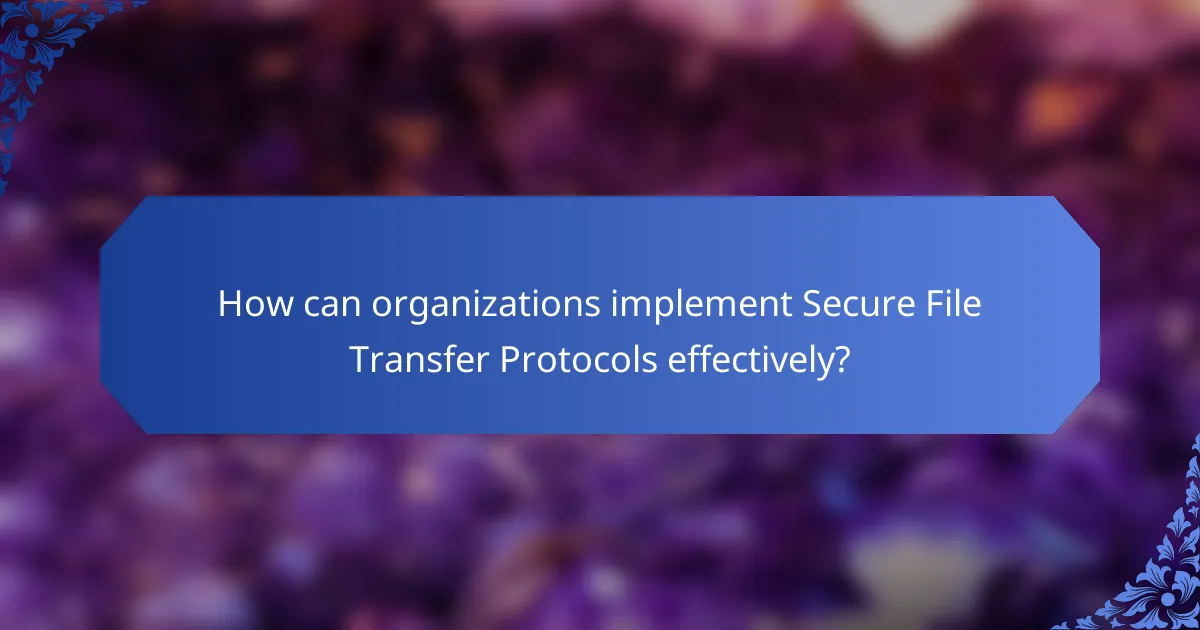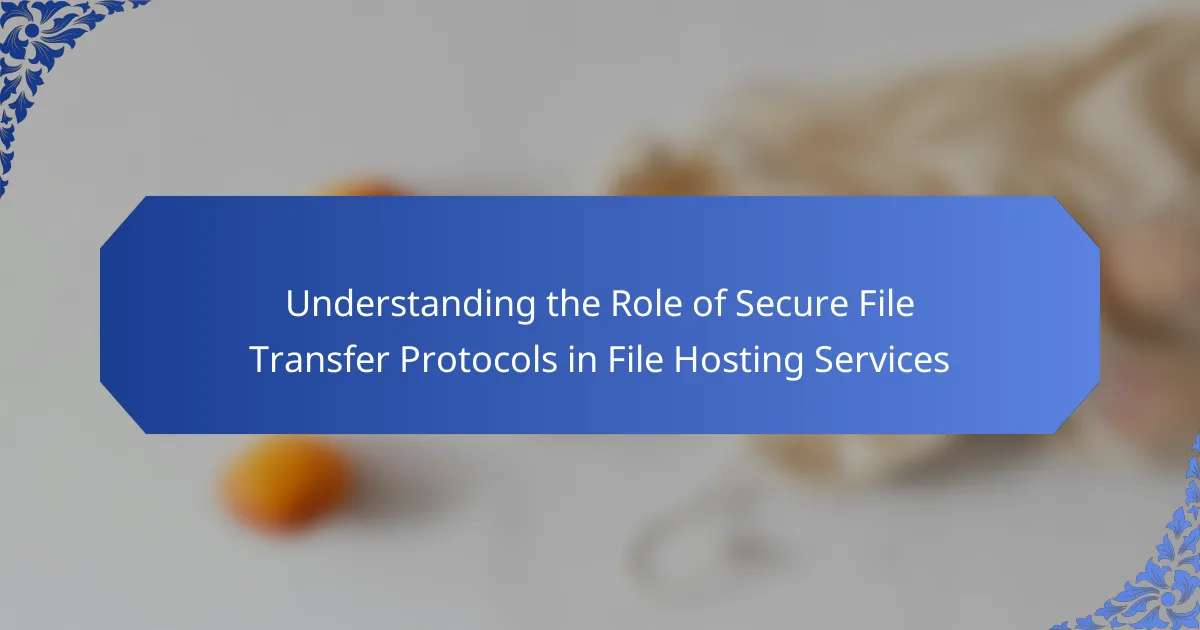Secure File Transfer Protocols (SFTP) are essential methods for securely transferring files over a network, ensuring data integrity and confidentiality through encryption and authentication. Key protocols include SFTP, which utilizes SSH for secure transfers; FTPS, which enhances traditional FTP with SSL/TLS security; and HTTPS, which encrypts data exchanged between web browsers and servers. The article outlines the importance of these protocols in protecting sensitive information, details best practices for implementing SFTP effectively, and emphasizes the need for organizations to establish clear policies, conduct regular training, and perform security assessments to maintain robust data security.

What are Secure File Transfer Protocols?
Secure File Transfer Protocols are methods used to securely transfer files over a network. They provide encryption and authentication to protect data during transmission. Common protocols include SFTP, FTPS, and HTTPS. SFTP, or Secure File Transfer Protocol, uses SSH to secure file transfers. FTPS, or FTP Secure, adds SSL/TLS security to the traditional FTP protocol. HTTPS, or Hypertext Transfer Protocol Secure, encrypts data between a web browser and server. These protocols ensure data integrity and confidentiality, reducing the risk of unauthorized access. According to a report by Cybersecurity & Infrastructure Security Agency, secure file transfer protocols are essential for protecting sensitive information in transit.
How do Secure File Transfer Protocols function?
Secure File Transfer Protocols function by encrypting data during transmission to ensure security. They establish a secure connection between client and server using cryptographic techniques. This process involves authentication to verify the identity of both parties. Data is then transmitted over a secure channel, preventing unauthorized access. Common protocols include SFTP and FTPS, which add layers of security to standard file transfer methods. Encryption methods like SSL/TLS are often used for this purpose. These protocols help protect sensitive information from interception during transfer.
What are the key components of Secure File Transfer Protocols?
The key components of Secure File Transfer Protocols include encryption, authentication, integrity checks, and secure connections. Encryption protects data during transfer, ensuring confidentiality. Authentication verifies the identities of users and systems involved in the transfer. Integrity checks confirm that the data has not been altered during transmission. Secure connections, such as SSL/TLS, establish a safe communication channel. These components work together to enhance security in file transfers.
How do encryption methods enhance security in file transfers?
Encryption methods enhance security in file transfers by converting data into a coded format. This process ensures that only authorized users can access the original information. Encryption protects data from unauthorized interception during transmission. It uses algorithms to scramble the data, making it unreadable to potential attackers. For example, AES (Advanced Encryption Standard) is widely used for its strong security. Additionally, encryption can include authentication measures to verify the identity of users. This adds an extra layer of security to the file transfer process. According to a 2021 study by Ponemon Institute, 60% of data breaches occur during data in transit, highlighting the importance of encryption. By mitigating these risks, encryption methods play a critical role in secure file transfer protocols.
Why are Secure File Transfer Protocols important for file hosting services?
Secure File Transfer Protocols are crucial for file hosting services as they ensure the confidentiality and integrity of data during transmission. These protocols encrypt files, protecting sensitive information from unauthorized access. For example, protocols like SFTP and FTPS utilize encryption methods to secure data. According to a report by the Ponemon Institute, 60% of organizations experienced a data breach due to insecure file transfers. Thus, using secure protocols mitigates the risk of data breaches. Additionally, regulatory compliance often mandates the use of secure transfer methods for sensitive data. This highlights the importance of Secure File Transfer Protocols in maintaining data security and compliance for file hosting services.
What risks do Secure File Transfer Protocols mitigate in file hosting?
Secure File Transfer Protocols (SFTP) mitigate several risks in file hosting, including data interception, unauthorized access, and data corruption. SFTP encrypts data during transmission, preventing interception by malicious actors. This encryption ensures that sensitive information remains confidential. Additionally, SFTP requires authentication, which reduces the risk of unauthorized access to files. By verifying user identities, SFTP helps ensure that only authorized individuals can access sensitive data. Furthermore, SFTP provides integrity checks, which detect any alterations to files during transfer. This feature protects against data corruption and ensures the authenticity of the transmitted files. Overall, SFTP enhances security in file hosting by addressing these critical risks effectively.
How do these protocols ensure data integrity during transfers?
Secure file transfer protocols ensure data integrity during transfers by implementing mechanisms such as checksums, encryption, and error detection. Checksums verify that the data has not been altered during transmission. Encryption protects the data from unauthorized access and tampering. Error detection protocols identify any discrepancies that may occur during the transfer process. These measures collectively maintain the accuracy and consistency of the data being transferred. For example, protocols like SFTP and FTPS use these techniques to ensure that files remain intact from sender to receiver.

What types of Secure File Transfer Protocols are commonly used?
The commonly used Secure File Transfer Protocols include SFTP, FTPS, and HTTPS. SFTP, or SSH File Transfer Protocol, operates over a secure shell and encrypts data during transfer. FTPS, or FTP Secure, adds SSL/TLS encryption to traditional FTP. HTTPS, or Hypertext Transfer Protocol Secure, is used for secure web-based file transfers. These protocols ensure confidentiality and integrity of data. Their use is critical in environments requiring secure file sharing.
How does FTP differ from SFTP and FTPS?
FTP, SFTP, and FTPS are all protocols for transferring files, but they differ significantly in security features. FTP, or File Transfer Protocol, transmits data in plaintext, making it vulnerable to interception. SFTP, or SSH File Transfer Protocol, encrypts data during transmission, providing a secure channel. FTPS, or FTP Secure, adds SSL/TLS encryption to the traditional FTP protocol, ensuring secure data transfer. Unlike FTP, both SFTP and FTPS protect sensitive information from eavesdropping. The choice between SFTP and FTPS often depends on specific security requirements and server configurations.
What are the advantages of using SFTP over traditional FTP?
SFTP offers enhanced security compared to traditional FTP. SFTP encrypts data during transfer, protecting it from eavesdropping. Traditional FTP transmits data in plain text, making it vulnerable to interception. SFTP also provides secure authentication methods, such as public key authentication. This reduces the risk of unauthorized access. Additionally, SFTP operates over a single connection, simplifying firewall configurations. In contrast, FTP uses multiple connections, which can complicate network security. These advantages make SFTP a preferred choice for secure file transfers in various industries.
In what scenarios is FTPS preferred over SFTP?
FTPS is preferred over SFTP in scenarios requiring compliance with specific regulations. For example, FTPS supports compliance with PCI DSS, which mandates secure file transmission for payment data. FTPS also integrates well with existing FTP infrastructures, making it easier for organizations to adopt without significant changes. Additionally, FTPS can work with firewalls more seamlessly since it uses standard ports like 21 for control and 20 for data transfer. This compatibility can simplify network configurations. Furthermore, FTPS allows for the use of client certificates for authentication, enhancing security in certain environments. These factors make FTPS suitable for industries with strict regulatory requirements and existing FTP dependencies.
What are the key features of various Secure File Transfer Protocols?
Secure File Transfer Protocols are designed to ensure safe and reliable data transmission. Key features include encryption, which secures data during transfer. Authentication verifies the identity of users before access. Integrity checks ensure data is not altered during transmission. Protocols like SFTP and FTPS use Secure Shell and SSL/TLS for security. These protocols also support various file types and sizes. User-friendly interfaces enhance accessibility for users. Logging and monitoring capabilities track file transfer activities for compliance and security.
How do authentication mechanisms vary across different protocols?
Authentication mechanisms differ significantly across various protocols. For example, HTTP uses Basic Authentication, which transmits credentials in an encoded format. In contrast, HTTPS employs SSL/TLS for secure encrypted connections and utilizes certificates for authentication. FTP relies on username and password authentication but lacks encryption by default. However, FTPS and SFTP enhance security by adding encryption and using public key authentication. Each protocol’s choice of authentication reflects its security requirements and use cases. The differences in mechanisms impact the overall security and user experience in file transfer processes.
What role does user access control play in Secure File Transfer Protocols?
User access control is essential in Secure File Transfer Protocols (SFTP) as it regulates who can access and transfer files. It ensures that only authorized users can perform specific actions, thereby enhancing security. By implementing user access control, organizations can prevent unauthorized access to sensitive data. This control mechanism often includes user authentication and permission settings. For instance, users may be granted read-only access or full permissions based on their roles. The effectiveness of SFTP relies heavily on these access controls to mitigate risks of data breaches. Studies have shown that proper user access management significantly reduces the likelihood of unauthorized file transfers.

How can organizations implement Secure File Transfer Protocols effectively?
Organizations can implement Secure File Transfer Protocols (SFTP) effectively by following a structured approach. First, they should assess their file transfer needs and select an appropriate SFTP solution. This involves evaluating factors such as security requirements, user access controls, and integration with existing systems. Next, organizations must configure the SFTP server properly. This includes setting strong authentication methods, such as key-based authentication, and enforcing encryption standards for data in transit.
Additionally, organizations should establish clear policies and procedures for file transfer activities. This includes defining user roles, permissions, and audit logging practices to monitor file transfers. Regular training for employees on secure file transfer practices is essential. This ensures that staff understand the importance of security measures and how to use the SFTP system effectively.
Finally, organizations should conduct periodic security assessments and updates. Regularly reviewing the SFTP implementation helps identify vulnerabilities and ensures compliance with security standards. Following these steps enables organizations to leverage SFTP effectively while maintaining data security and integrity.
What best practices should be followed for secure file transfers?
Use encryption to protect files during transfer. Encryption ensures that data is unreadable to unauthorized users. Implement secure protocols like SFTP or FTPS. These protocols provide an additional layer of security compared to standard FTP. Regularly update software to patch vulnerabilities. Keeping software current reduces the risk of exploitation. Use strong, unique passwords for file access. Weak passwords can be easily compromised. Limit access to files based on user roles. This minimizes the number of individuals who can view sensitive information. Monitor file transfer logs for unusual activity. Regular monitoring helps identify potential security breaches.
How can organizations educate employees about secure file transfer practices?
Organizations can educate employees about secure file transfer practices through training sessions and workshops. These sessions can cover the importance of using secure protocols like SFTP and HTTPS. Employees should learn about the risks of unsecured file transfers, such as data breaches. Providing real-world examples of breaches can reinforce these risks. Organizations can also implement regular refresher courses to keep knowledge current. Additionally, creating easy-to-follow guidelines can help employees remember best practices. Using interactive tools and quizzes can enhance engagement during training. Regularly updating materials ensures that employees are aware of the latest security measures.
What tools can assist in managing Secure File Transfer Protocols?
FileZilla, WinSCP, and Cyberduck are tools that assist in managing Secure File Transfer Protocols. FileZilla is an open-source FTP client that supports SFTP and FTPS. WinSCP is another popular tool that provides a graphical interface for SFTP and SCP. Cyberduck is a user-friendly client that supports SFTP, WebDAV, and other protocols. These tools simplify the process of transferring files securely. They provide encryption and authentication features to protect data during transfer. Each tool has specific features tailored for different user needs. Their widespread use in various industries demonstrates their effectiveness in managing secure file transfers.
What common challenges do organizations face when using Secure File Transfer Protocols?
Organizations face several common challenges when using Secure File Transfer Protocols (SFTP). One major challenge is ensuring compatibility with existing systems. Many organizations use various software and hardware configurations, which can lead to integration issues. Another challenge is the complexity of configuration and management. Properly setting up SFTP requires technical expertise, which may not be readily available.
Security concerns also pose significant challenges. While SFTP is designed to be secure, vulnerabilities can arise from improper implementation or outdated software. Additionally, organizations often face user training issues. Employees may not be familiar with SFTP processes, leading to errors or security breaches.
Compliance with data protection regulations can also be a challenge. Organizations must ensure that their SFTP practices meet legal standards. Finally, performance issues can arise, particularly when transferring large files. Network bandwidth limitations can slow down file transfers, impacting productivity.
How can organizations troubleshoot connectivity issues with these protocols?
Organizations can troubleshoot connectivity issues with secure file transfer protocols by following systematic steps. First, they should verify network connectivity. This includes checking if devices can communicate over the network. Next, they must confirm the correct configuration of the protocols. Misconfigurations often lead to connectivity failures.
Additionally, organizations should review firewall settings. Firewalls may block necessary ports or protocols, causing disruptions. They can also use diagnostic tools to trace connection paths. Tools like ping and traceroute help identify where issues arise.
Monitoring logs from the file transfer applications is crucial. Logs provide insights into errors and connection attempts. Lastly, organizations should ensure that software is up to date. Outdated software can lead to compatibility issues and vulnerabilities. Following these steps can help resolve many connectivity problems effectively.
What are the implications of outdated protocols on security?
Outdated protocols significantly weaken security measures. They often lack modern encryption standards. This makes data vulnerable to interception. Attackers can exploit known vulnerabilities in these protocols. For instance, older protocols like FTP do not encrypt data. Consequently, sensitive information can be exposed during transmission. Additionally, outdated protocols may not support current authentication methods. This increases the risk of unauthorized access. Regular updates and adherence to current standards are essential for maintaining security.
What future trends are emerging in Secure File Transfer Protocols?
Emerging trends in Secure File Transfer Protocols (SFTP) include increased adoption of cloud-based solutions. Organizations are shifting toward cloud storage for scalability and accessibility. Enhanced encryption methods are also being implemented for better data protection. This includes the use of advanced algorithms such as AES-256. Additionally, integration of Artificial Intelligence (AI) is on the rise. AI is being used to detect anomalies and improve security protocols. Furthermore, there is a growing emphasis on regulatory compliance. Companies are focusing on adhering to standards like GDPR and HIPAA. Lastly, user-friendly interfaces are becoming a priority for improving the user experience. These trends reflect the evolving landscape of secure file transfer needs.
How is the rise of cloud computing influencing Secure File Transfer Protocols?
The rise of cloud computing is significantly influencing Secure File Transfer Protocols (SFTP). Cloud services increase the demand for secure data transfer methods. SFTP is essential for protecting sensitive information during online transactions. Enhanced security features in cloud platforms promote the adoption of SFTP. According to a report by MarketsandMarkets, the global SFTP market is expected to grow substantially due to cloud integration. Furthermore, cloud computing enables easier scalability of SFTP solutions. This flexibility allows businesses to adapt to changing data transfer needs. As a result, SFTP is becoming a standard practice in cloud environments.
What innovations are being developed to enhance file transfer security?
Innovations in file transfer security include end-to-end encryption, blockchain technology, and zero-trust architecture. End-to-end encryption ensures that files are encrypted on the sender’s device and only decrypted on the recipient’s device. This prevents unauthorized access during transmission. Blockchain technology offers a decentralized method to verify file integrity and authenticity. It creates an immutable record of file transfers. Zero-trust architecture requires continuous verification of user identity and device security before granting access to files. These innovations address vulnerabilities in traditional file transfer methods. According to a 2021 report by Cybersecurity Ventures, the global cost of cybercrime is projected to reach $10.5 trillion annually by 2025, highlighting the importance of these advancements.
Secure File Transfer Protocols (SFTP) are essential methods for securely transferring files over networks, ensuring data protection through encryption and authentication. This article provides an overview of various secure protocols, including SFTP, FTPS, and HTTPS, and their importance in maintaining data integrity and confidentiality during file transfers. It discusses the key components and functionality of these protocols, the risks they mitigate, and best practices for implementation. Additionally, the article highlights emerging trends and innovations in file transfer security, emphasizing the critical role of these protocols in file hosting services and regulatory compliance.
